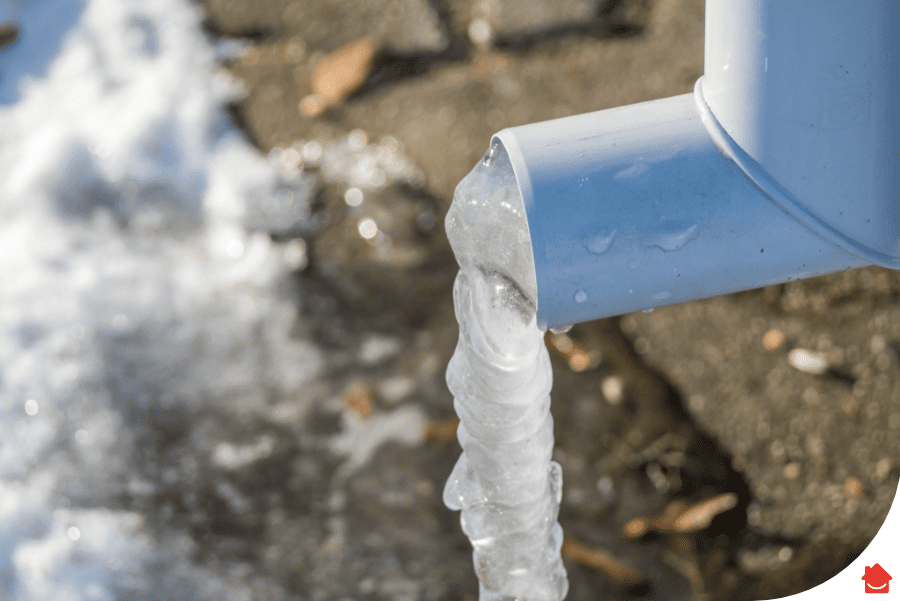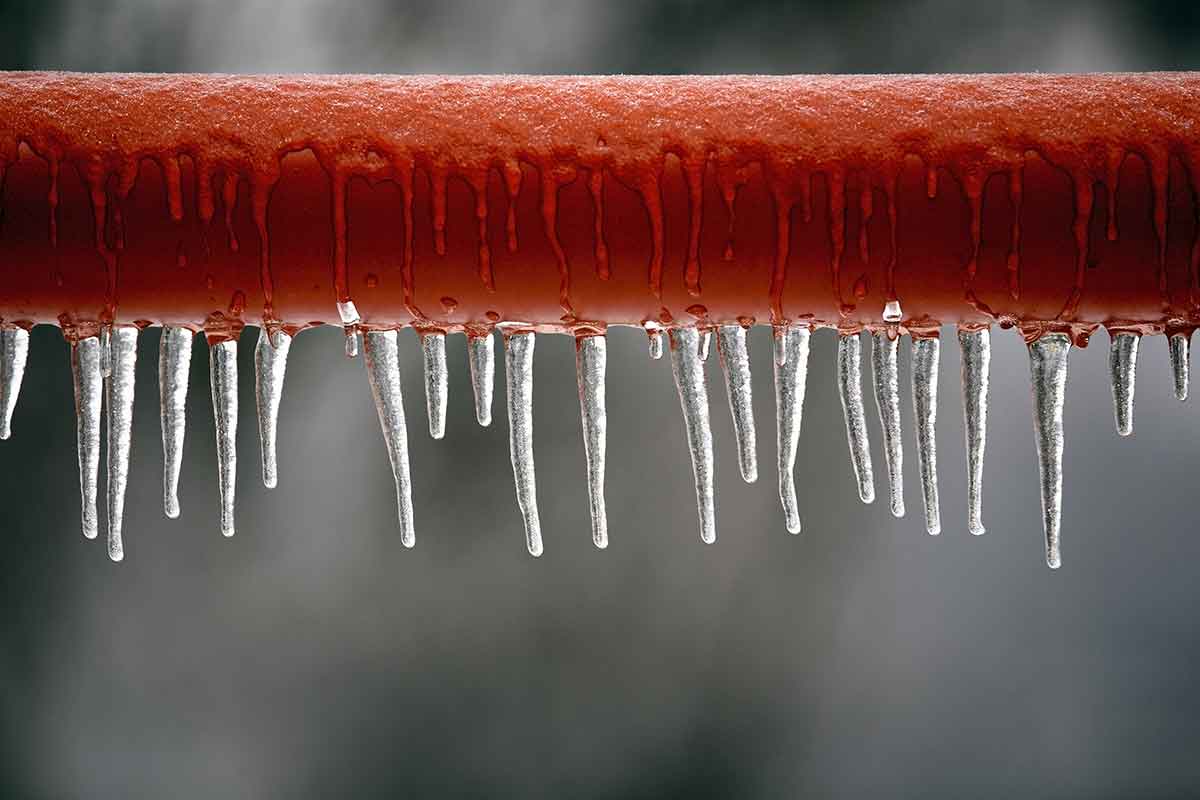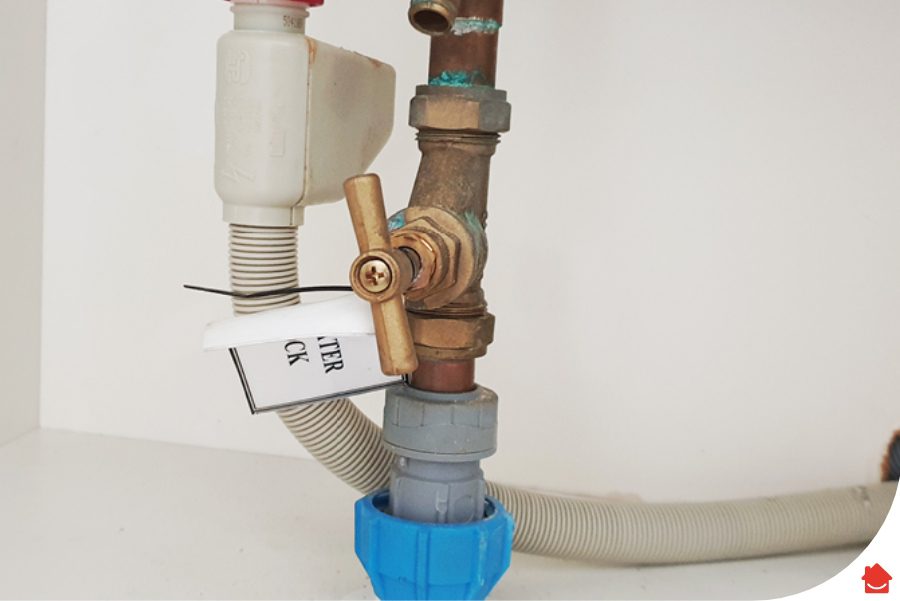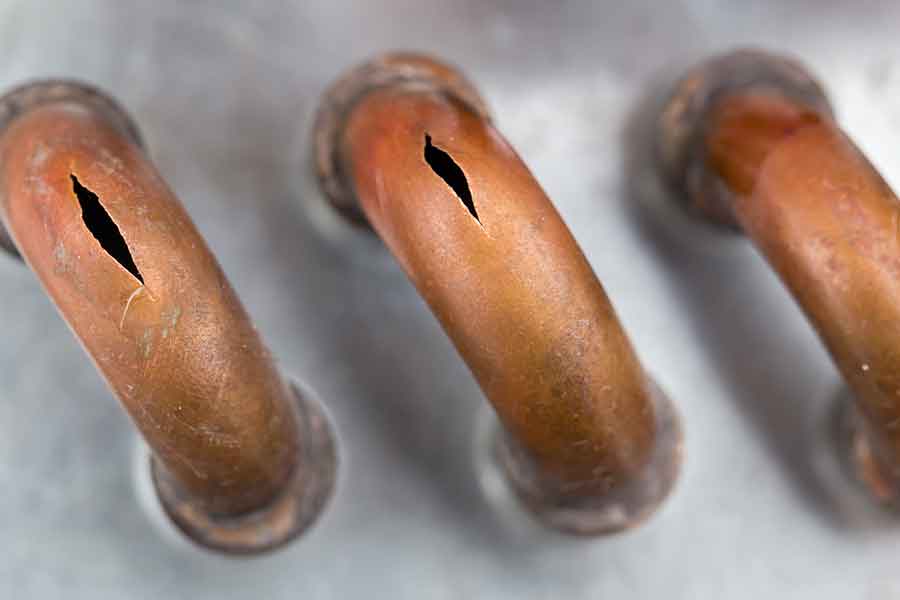Frozen pipes are the last thing you want in the depths of Winter. Unfortunately, living in our chilly old British Isles they’re a major concern, as drops in temperature can stop our entire water supply dead—and even lead to burst pipes.
Jump to:
Why do pipes freeze in winter?
Naturally, cold weather leaves your pipes vulnerable to freezing. However, other factors do influence how likely it is for your pipes to freeze:
- Insufficient insulation for your pipes.
- Cracks or gaps in pipes, usually at the point where the pipe enters the home leaving them exposed to icy draughts.
- Pipes inside cupboards. If your cupboard doors are closed, warm air will not reach these pipes leaving the extra chilly.
What temperature do pipes freeze in the UK?
In order for pipes to freeze, the outside temperature needs to be below -6 degrees Celsius for at least 6 consecutive hours. Even so, if water is moving and flowing then it’s difficult for it to freeze.
What happens when your pipes freeze?
Typically your water flow will just stop—they won’t burst straight away. Surprisingly, pipes don’t usually burst at the spot an ice blockage has occurred. Instead, bursts are an effect of water freezing and expanding inside your household pipes.

Continual freezing and expansion of water inside the pipe causes pressure to build up between the ice blockage and the closed tap. Repeated pressure on the same section of the pipe results in this eventually bursting. And that means you need to fix the burst pipe, fast, before it does too much damage to your property.
Where in the house do pipes freeze?
Frozen pipes usually occur in the unheated, coldest areas of your home, such as your loft, an unfinished cellar or a garage. Naturally, these less insulated areas mean a colder environment for your pipes, and increase the chance they can freeze.
Do hot water pipes freeze?
Yes, hot water pipes freeze just as often as cold water pipes. Some people are even adamant that hot water pipes are more likely to freeze, and faster, although this is regularly debated by scientists.
Will plastic pipes freeze?
Plastic or copper—no matter what type of pipes you have inside or outside your property, they will freeze and burst if water is inside of them. This means the plastic condensate pipe from your boiler to your outside drain too, so it’s worth knowing how to thaw your condensate pipe, too.
How to tell if your pipes are frozen
The first sign of a frozen pipe is easy to spot: try turning on your tap. If no water comes out, check under the kitchen sink to see if the mains is still on. Next, check to see if there is a leak near the tap that’s not working.
Not spotted anything yet? Follow the pipe from the inactive tap to check for a burst pipe. You can spot this if water is spraying, dripping, or icicles have formed if the pipe burst a while ago. If the pipe is behind a wall you may see a damp floor, wall or ceiling.
If the pipe is frozen but hasn’t burst, you’ll either see some ice, frost, or the pipe may be bulging slightly.

How to keep frozen water pipes from bursting
Pipes don’t always burst once they’re frozen or during the process of freezing. The force created by the expansion of the water turning from a liquid to a solid can rupture the pipe wall, this would only be identified when the ice thaws.
Will frozen pipes thaw on their own?
Technically, yes, frozen pipes can thaw on their own. But do you really want to wait and watch while the ice thaws and potentially causes a burst pipe?
If your search reveals that your pipe is frozen but hasn’t burst, you need to thaw the pipe yourself or, if you’re not comfortable doing this, call a professional who can.
How to fix frozen pipes and defrost them
Dealing with frozen pipes is tricky business. If your pipes do freeze over the winter months, there are a number of steps you can take to fix your frozen pipes quickly and safely.
Step 1: Identify the blockage
If one of your pipes is frozen, you’ll need to find out where the blockage is located before taking action. You can do this by:
- Looking for evidence of freezing along the pipes.
- Using your hands to feel along the pipe until you reach a section that feels colder than the rest. You may find it helpful to compare the temperature of the blocked pipe to that of a pipe where you know the water is flowing freely.
Remember, during very cold weather, you may find multiple frozen areas within one pipe. This is especially common in exposed sections of pipe (such as pipes exposed to draughts or where a pipe enters your home).
Step 2: Protect your possessions
If a pipe appears to be frozen, protect everything around it to avoid any damage if it bursts. Move smaller items out of the way and cover up larger items.
Step 3: Turn off the stop tap
Turn off the main stop tap. You should find this under the kitchen sink or where the service pipe enters your home. If you have a cold water tank, turn off the stopcock (this is usually found in the attic or loft).

Step 4: Run the closest tap
Open the cold tap closest to the part of the pipe that’s frozen. This will allow for water to flow through the pipe, which will speed up the thawing process. The water will then be able to flow away when it melts.
Step 5: Start defrosting
Using a hairdryer, carefully thaw the ice in the pipe. Start at the tap end and work backwards towards the cold water tank. Take care as the pipe could burst at any time and spray water as it starts to thaw.
If you don’t own a hairdryer you can slowly thaw out the frozen section by covering it with hot water bottles or heat packs.
Remember, never use a naked flame or a heat gun to thaw out ice as this could damage your pipes and creates a fire hazard.
Step 6: Check pipe for damage
Once you’ve thawed out your pipes, check them thoroughly for any signs of damage or leaking. If the pipes have been damaged, you will need to call out an emergency plumber to fix the problem.

Step 7: Turn on the taps
Once the blockage has thawed, turn your stop tap and stopcock back on and run water until normal flow is restored.
If a frozen pipe does burst, it’s important to know the best way to remove the water and sort out any damage to your home and possessions.
How to prevent frozen pipes
While we can’t control the weather, we can definitely take steps to avoid frozen pipes, cold baths and shivering children during Winter.
Get insulated
Insulating your roof, walls, ceilings and floor can all help stop heat escaping. Key areas to insulate are your loft and the sides of your water tanks. Wrap pipes in lagging (a foam material that insulates and reinforces them). You will find this at most DIY stores.
Keep out the cold
If your home is particularly susceptible to freezing pipes, regulate your thermostat! It needs to be set at the same temperature every day. Don’t let it fall below 12 degrees Celsius when you leave your home.
Most modern boilers have a frost protection thermostat which turns up automatically if the temperature drops to a level that will cause frozen pipes. When it starts to get cold, make sure this function is on, and working.
In very cold weather, it is best to leave your heating on a low setting or set it to come on a couple of times a day. Keep this in mind if you are going on holiday for longer than a day or two.
Find your stopcock
Do you know where your home’s stopcock is? You should locate your stopcock and check it regularly to ensure you can turn it off easily in an emergency. You may find it helpful to label your stopcock, so you can easily locate it if you’re in a panic.
Check pipes regularly
If you’re going away for a while, ask a friend, relative or neighbour to check your home regularly to ensure your pipes haven’t burst or frozen. You can always repay the favour when they next go on holiday.
Maintain your taps
It is vital to replace washers in dripping taps: if they freeze, they’ll block your pipes.
You should also always disconnect your garden hose from your external tap, drain the hose and then store it in your garage or shed. You can also close the indoor valves that feed into these outdoor taps, so make sure you do that too.
Keep your pipes protected, no matter the weather
Our Plumbing and Drainage Plus cover covers you for burst or frozen pipes, leaking pipes, blocked drains, blocked sinks and toilets, and dripping or seized taps.
If you’re looking for a one-off home repair, we can also send an experienced plumber or Gas Safe registered engineer to help in a jiffy. Simply call us for a one-off emergency repair and one of our Excellent-rated approved plumbers will quickly arrive to sort your frozen pipes, wherever you live in the UK.



